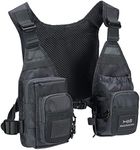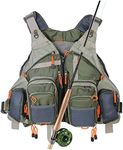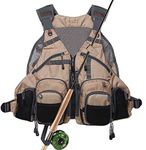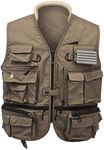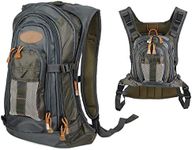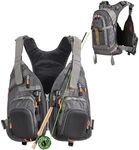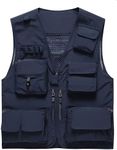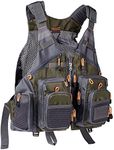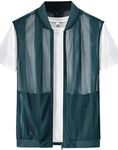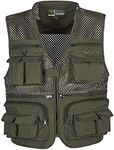Buying Guide for the Best Fly Fishing Vests
Choosing the right fly-fishing vest is crucial for a comfortable and efficient fishing experience. A good vest will help you keep your gear organized and easily accessible, allowing you to focus on fishing rather than fumbling through your equipment. When selecting a fly-fishing vest, consider the following key specifications to ensure you find the best fit for your needs.MaterialThe material of the vest is important for durability, comfort, and weather resistance. Common materials include nylon, polyester, and mesh. Nylon and polyester are durable and water-resistant, making them suitable for various weather conditions. Mesh vests are lightweight and breathable, ideal for hot weather. Choose a material based on the typical weather conditions you fish in and your comfort preferences.
Pockets and StorageThe number and type of pockets are crucial for organizing your gear. Vests can have a range of pockets, from a few large ones to many small ones. If you carry a lot of gear, look for a vest with multiple pockets of different sizes to keep everything organized. For minimalists, a vest with fewer, larger pockets might be sufficient. Consider what gear you typically carry and choose a vest that can accommodate it all.
Fit and AdjustabilityA well-fitting vest is essential for comfort and mobility. Vests come in various sizes and often feature adjustable straps to ensure a snug fit. Some vests are designed to fit over layers of clothing, while others are more form-fitting. Try on different vests to see which one feels most comfortable and allows for a full range of motion. Adjustable vests are versatile and can be tailored to fit your body shape and the amount of clothing you wear.
WeightThe weight of the vest can affect your comfort, especially during long fishing trips. Heavier vests may offer more storage and durability, but they can also be cumbersome. Lightweight vests are more comfortable for extended wear but may have fewer features. Consider how long you typically fish and how much gear you carry to determine the right balance between weight and functionality.
VentilationVentilation is important for staying cool and comfortable, especially in warm weather. Vests with mesh panels or breathable fabrics allow air to circulate, reducing sweat and overheating. If you often fish in hot climates, look for a vest with good ventilation. For cooler weather, ventilation may be less of a priority, and you might prefer a vest that offers more insulation.
Water ResistanceWater resistance is a valuable feature for keeping your gear dry in wet conditions. Some vests are made from water-resistant materials or have water-resistant coatings. If you frequently fish in rainy or wet environments, a water-resistant vest can help protect your gear. For dry conditions, this feature may be less critical, and you can focus on other aspects like storage and fit.
Attachment PointsAttachment points, such as D-rings and loops, are useful for securing tools and accessories. These points allow you to attach items like nets, pliers, and tippet spools for easy access. If you use a lot of tools, look for a vest with multiple attachment points. For those who prefer a minimalist approach, fewer attachment points may be sufficient. Consider your typical fishing setup and choose a vest that accommodates your tools and accessories.
